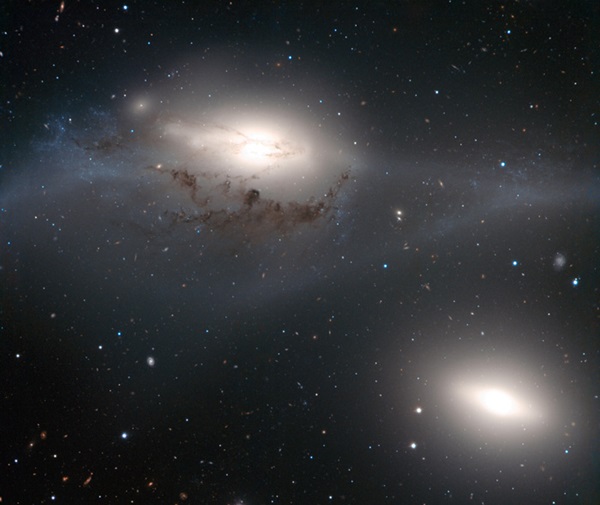Key Takeaways:
The Eyes are about 50 million light-years away in the constellation Virgo the Virgin and are some 100,000 light-years apart. The nickname comes from the apparent similarity between the cores of this pair of galaxies — two white ovals that resemble a pair of eyes glowing in the dark when seen in a moderate-sized telescope.
Although the centers of these two galaxies look similar, their outskirts could not be more different. The galaxy in the lower right, known as NGC 4435, is compact and seems to be almost devoid of gas and dust. In contrast, in the large galaxy in the upper left (NGC 4438), a lane of obscuring dust is visible just below its nucleus, young stars can be seen left of its center, and gas extends at least up to the edges of the image.
A violent process stripped the contents of NGC 4438: a collision with another galaxy. This clash has distorted the galaxy’s spiral shape. The same could happen to the Milky Way when it collides with its neighboring galaxy, Andromeda, in 3 or 4 billion years.
NGC 4435 could be the culprit. Some astronomers believe that the damage caused to NGC 4438 resulted from an approach between the two galaxies to within about 16,000 light-years that happened about 100 million years ago. But while the larger galaxy was damaged, the smaller one was significantly more affected by the collision. Gravitational tides from this clash are probably responsible for ripping away the contents of NGC 4438, and for reducing NGC 4435’s mass and removing most of its gas and dust.
Another possibility is that the giant elliptical galaxy M86, farther away from The Eyes and not visible in this image, was responsible for the damage caused to NGC 4438. Recent observations have found filaments of ionized hydrogen gas connecting the two large galaxies, indicating that they may have collided in the past.
The elliptical galaxy M86 and The Eyes belong to the Virgo cluster, a rich grouping of galaxies. In such close quarters, galaxy collisions are fairly frequent, so perhaps NGC 4438 suffered from encounters with both NGC 4435 and M86.
The Eyes are about 50 million light-years away in the constellation Virgo the Virgin and are some 100,000 light-years apart. The nickname comes from the apparent similarity between the cores of this pair of galaxies — two white ovals that resemble a pair of eyes glowing in the dark when seen in a moderate-sized telescope.
Although the centers of these two galaxies look similar, their outskirts could not be more different. The galaxy in the lower right, known as NGC 4435, is compact and seems to be almost devoid of gas and dust. In contrast, in the large galaxy in the upper left (NGC 4438), a lane of obscuring dust is visible just below its nucleus, young stars can be seen left of its center, and gas extends at least up to the edges of the image.
A violent process stripped the contents of NGC 4438: a collision with another galaxy. This clash has distorted the galaxy’s spiral shape. The same could happen to the Milky Way when it collides with its neighboring galaxy, Andromeda, in 3 or 4 billion years.
NGC 4435 could be the culprit. Some astronomers believe that the damage caused to NGC 4438 resulted from an approach between the two galaxies to within about 16,000 light-years that happened about 100 million years ago. But while the larger galaxy was damaged, the smaller one was significantly more affected by the collision. Gravitational tides from this clash are probably responsible for ripping away the contents of NGC 4438, and for reducing NGC 4435’s mass and removing most of its gas and dust.
Another possibility is that the giant elliptical galaxy M86, farther away from The Eyes and not visible in this image, was responsible for the damage caused to NGC 4438. Recent observations have found filaments of ionized hydrogen gas connecting the two large galaxies, indicating that they may have collided in the past.
The elliptical galaxy M86 and The Eyes belong to the Virgo cluster, a rich grouping of galaxies. In such close quarters, galaxy collisions are fairly frequent, so perhaps NGC 4438 suffered from encounters with both NGC 4435 and M86.










